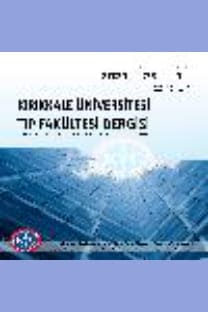ANNELERİN SÜT DİŞLENME İLE İLGİLİ BİLGİ VE DENEYİMLERİNİN DEĞERLENDİRİLMESİ
Evaluation of Knowledge and Experiences of Mothers on Teething
___
- 1. Cahill DR, Marks SC Jr. Tooth eruption: evidence for the central role of the dental follicle. J Oral Pathol. 1980;9(4):189-200.
- 2. Buckler JMH. A Reference Manual of Growth and Development. 2nd ed. Oxford. Blackwell Science, 1997:20-66.
- 3. Macknin ML, Piedmonte M, Jacobs J, Skibinski C. Symptoms associated with infant teething: a prospective study. Pediatrics. 2000;105(4):747-52.
- 4. McIntyre GT, McIntyre GM. Teething troubles? Br Dent J. 2002;192(5):251-5.
- 5. Romero-Maroto M, Sáez-Gómez JM. Eruption of primary dentition- a grave health problem according to Spanish doctors of the XVI-XVIII centuries. J Dent Res. 2009;88(9):777-80.
- 6. Owais AI, Zawaideh F, Bataineh O. Challenging parents’ myths regarding their children’s teething. Int J Dent Hyg. 2010;8(1):28-34.
- 7. Wake M, Hesketh K, Lucas J. Teething and tooth eruption in infants: a cohort study. Pediatrics. 2000;106(6):1374-9.
- 8. Jaber L, Cohen IJ, Mor A. Fever associated with teething. Arch Dis Child. 1992;67(2):233-4.
- 9. Plutzer K, Keirse MJNC. Teething: a problem for children, parents and their doctors. Med Today. 2011;12(12):44-8.
- 10. Kozuch M, Peacock E, D’Auria JP. Infant teething information on the world wide web: taking a byte out of the search. J Pediatr Health Care. 2015;29(1):38-45.
- 11. Honig PJ. Teething are today’s pediatricians using yesterday’s notions? J Pediatr. 1975;87(3):415-7.
- 12. Wake M, Hesketh K. Teething symptoms: cross sectional survey of five groups of child health professionals. BMJ. 2002;325(7368):814.
- 13. Swann IL. Teething complications, a persisting misconception. Postgrad Med J. 1979;55(639):24-5.
- 14. Pani SC, Badea L, Mirza S, Elbaage N. Differences in perceptions of early childhood oral health-related quality of life between fathers and mothers in Saudi Arabia. Int J Paediatr Dent. 2012;22(4):244-9.
- 15. Kumar S, Tadakamadla J, Idris A, Busaily IA, AlIbrahim AY. Knowledge of teething and prevalence of teething myths in mothers of Saudi Arabia. J Clin Pediatr Dent. 2016;40(1):44-8.
- 16. Kakatkar G, Nagarajappa R, Bhat N, Prasad V, Sharda A, Asawa K. Parental beliefs about children's teething in Udaipur, India: a preliminary study. Braz Oral Res. 2012;26(2):151-7.
- 17. Holt R, Roberts G, Scully C. ABC of oral health. Oral health and disease. BMJ. 2000;320(7250):1652-5.
- 18. Tsang AK. Teething, teething pain and teething remedies. Int Dent SA. 2010;12:48-61.
- 19. Kılınç G, Edem P, Günay T, Aydın A, Halıcıoğlu O, Sevinç N. Annelerin çocuklarının süt dişlerinin sürmesi ile ilgili şikâyet ve yaklaşımları. Turkiye Klinikleri J Dental Sci. 2015;21(2):90-4.
- 20. Adimorah GN, Ubesie AC, Chinawa JM. Mothers' beliefs about infant teething in Enugu, South-east Nigeria: a cross sectional study. BMC Res Notes 2011;4:228.
- 21. Uti OG, Savage KO, Ekanem EE. Maternal beliefs about infant teething. J Community Med Prim Health Care. 2005;17:61-4.
- 22. Bankole OO, Taiwo JO, Adesakin AM. Teething in infants- Knowledge and attitude of traditional birth attendants in Ibadan, Nigeria. Health. 2013;5(9):1406-11.
- 23. Ramos-Jorge J, Pordeus IA, Ramos-Jorge ML, Paiva SM. Prospective longitudinal study of signs and symptoms associated with primary tooth eruption. Pediatrics. 2011;128(3):471-7.
- 24. Tighe M, Roe MF. Does a teething child need serious illness excluding? Arch Dis Child. 2007;92(3):266–8.
- 25. Cunha RF, Pugliesi DM, Garcia LD, Murata SS. Systemic and local teething disturbances: prevalence in a clinic for infants. J Dent Child (Chic). 2004;71(1):24-6.
- 26. Kiran K, Swati T, Kamala BK, Jaiswal D. Prevalence of systemic and local disturbances in infants during primary teeth eruption: a clinical study. Eur J Paediatr Dent. 2011;12(4):249-52.
- 27. Noor-Mohammed R, Basha S. Teething disturbances; prevalence of objective manifestations in children under age 4 months to 36 months. Med Oral Patol Oral Cir Bucal. 2012;17(3):491-4.
- 28. American Academy of Pediatric Dentistry. Clinical Affairs Committee-Infant Oral Health Subcommittee. Guideline on infant oral health care. Pediatr Dent. 2012;34:148-52.
- 29. Azevedo TD, Bezerra AC, de Toledo OA. Feeding habits and severe early childhood caries in Brazilian preschool children. Pediatr Dent. 2005;27(1):28-33.
- 30. Mohebbi SZ, Virtanen JI, Vahid-Golpayegani M, Vehkalahti MM. Feeding habits as determinants of early childhood caries in a population where prolonged breastfeeding is the norm. Community Dent Oral Epidemiol. 2008;36:363-9.
- ISSN: 2148-9645
- Yayın Aralığı: Yılda 3 Sayı
- Başlangıç: 1999
- Yayıncı: KIRIKKALE ÜNİVERSİTESİ KÜTÜPHANE VE DOKÜMANTASYON BAŞKANLIĞI
BİRGÜL CERİT, E. Büşra AYYILDIZ, Esra ÖZTÜRK
ANNELERİN SÜT DİŞLENME İLE İLGİLİ BİLGİ VE DENEYİMLERİNİN DEĞERLENDİRİLMESİ
HASTANELERDE SÜRVEYANS BİRİMİNİN KURULMASININ BULAŞICI HASTALIK BİLDİRİMLERİ ÜZERİNE ETKİSİ
Aslı HAYKIR SOLAY, Saadet ÜNSAL, Ali ACAR, Yunus GÜRBÜZ, Fatma ESER, Gülnur KUL, İrfan ŞENCAN
Ufuk CAKIR, CÜNEYT TAYMAN, Mehmet BÜYÜKTİRYAKİ
YOĞUN BAKIM HEMŞİRELERİNDE NÖBET SONRASI GÖZYAŞI BULGULARININ DEĞERLENDİRİLMESİ
Ali Hakim REYHAN, BURAK BİLGİN
KADIN CİNSEL İŞLEV ÖLÇEĞİNE ETKİ EDEN FAKTÖRLER
Buğra Bilge KESEROĞLU, Berat Cem ÖZGÜR, Ali Kaan YILDIZ, Esra GÜLEN
SEVAL BAYRAK, GÜLBAHAR USTAOĞLU, Emine Şebnem KURŞUN ÇAKMAK, CEMAL ATAKAN
Kırıkkale Yöresinde İnsan ve Hayvan Kaynaklarından İzole Edilen E. coli O157:H7’nin Prevalansı
TEOMAN ZAFER APAN, Murat YIDIRIM, MEHMET BAŞALAN, AYLİN KASIMOĞLU
